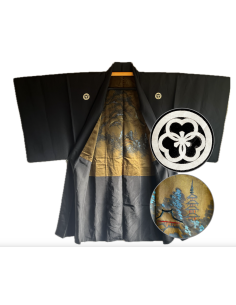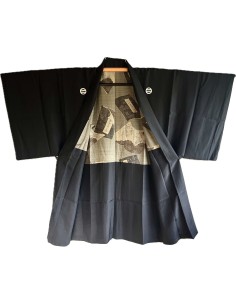Men's Deluxe Vintage Haori Zen Ryoanji Kyoto Japanese Zen Incense Set offered!
Zen-Ryoanji-Set
Last items in stock
€399.00
€499.00
-€100.00
Tax included
3-4 days
100% black silk.The stitched pattern on the inner silk lining represents the rocks of the dry Japanese garden of the famous Zen temple "Ryoanji" in Kyoto Kimono jacket.Reversible to wear for the practice of iaido or to exhibit.Made in Japan
- Made in Japan
- 100% pure black silk
- Golden silk lining
- Closing : "Himo" white silk or gold-coloured attachment cord offered! (your choice to select)Pattern: stitching representing the traditional Japanese dry garden of the famous Zen temple "Ryoanji" in Kyoto.

Kamon: adorned with 5 traditional Japanese family coat of arms of Matsunaga samurai clan
The Matsunaga clan (Mr. Matsunaga, Matsunaga-shi) is a Japanese samurai clan descended from the Fujiwara clan.

The lineage of Matsunaga Danjo Hisahide reinforces the Matsunaga clan's claim to
Fujiwara lineage through Hisahide's nephew, Tadatoshi Naito (also known as Naito Joan and Fujiwara John).

Tadatoshi Naito's mother was Naito Sadafusa who was from the Naito clan.
The Naito clan is descended from Fujiwara no Hidesato (Hokke (Fujiwara)).
Tadatoshi Naito is said to be the lord of Yagi Castle.
Hisahide's granddaughter, Matsunaga Teitoku (Matsunaga Teitoku) also strengthened the bond of the Matsunaga clan with the Fujiwara clan. His mother was the older sister of Fujiwara Seika (Fujiwara Seika). Teitoku's cousin was Tadatoshi Naito
Other sources suggest that the Matsunaga clan may have descended from the Minamoto clan and may be the descendants of Takenouchi no Sukune.
Dimension:
Height : 90cm
Shoulder to shoulder width : 57cm
Sleeve width : 33cm
Sleeve height : 48cm
Sleeve to sleeve width: 127cm
Period :hieisei (1989~)
Condition: excellent like new (see photo details)
Description: unique piece of Japanese traditional art, r are beautiful antique Haori, high quality silk reversible kimono jacket.
To display in your most beautiful interior or to wear over the kimono, samue or iaidoGi for the practice of Kenjutsu or other martial arts.
Also matched with any traditional or urban clothing.
 Free service : ironed, folded and wrapped in a "Kamon" coat of arms gift paper, you just have to offer it to the person of your choice.
Free service : ironed, folded and wrapped in a "Kamon" coat of arms gift paper, you just have to offer it to the person of your choice.
Gifts offered : to accompany this haori and provide you with a 100% ZEN atmosphere at home
- A black cast iron incense holder "IWACHU " (Made in Japan) (Value €49)
- A box of traditional Japanese sandalwood incense from the Zen Kenninji temple in Kyoto (Value €49)

After receiving and/or using this haori, please don't forget to leave us your testimony on our guestbook or share the photos of this work of art on social networks.
Note : after a little check on our site, you will see that our haori are in great demand and sold quickly because they are also on sale on our other stores and platforms Amazon, Etsy, Ebay. please.
To offer or to offer ourselves, we recommend the thoughtful purchase of this rare, authentic and unique antique haori for collectors and connoisseurs of Japanese art and enthusiasts of Japan.
Delivery: in order to ensure that you receive it perfectly, this haori will only be shipped with DHL EXPRESS (delay of 4 to 7 days)
Ryoanji Zen Temple Dry Japanese Garden

Ryōan-ji (竜安寺 / 龍安寺, literally "Dragon's Rest Temple" ) is a Zen temple located in northwest Kyoto, built in the 16th century, during the Muromachi period. It is part of the UNESCO World Heritage, being one of the historical monuments of ancient Kyoto. The temple belongs to the Myōshin-ji school of the Rinzai branch of Zen Buddhism. The temple site originally belonged to the Fujiwara clan.
The Stone Garden
For many, the temple's name evokes its famous stone garden, in the karesansui style, which is considered one of the masterpieces of Japanese Zen culture.

The garden was built in the late 15th or early 16th century, between 1499
and 1507. Its area is about 200 square meters.
It is surrounded to the south
and west by a low wall covered with a tiled roof, to the east by another low wall, and to the north
of a wooden veranda behind
which is the hōjō (the apartments of the superior of the temple).
Outside are maples and red pines that were probably not
not originally present.
Building on flat ground was a novelty at the time.
Fifteen stones, surrounded by moss, are arranged there in groups, from east to west, of five, of two, of three, of two then of three.
The small number of stones is also a novelty compared to other dry gardens of the same period: that of Daisen-in, for example, has more than a hundred, on a surface twice as small. The stone garden at Ryōan-ji belongs to the category of "gardens of nothingness" (mutei).
The paternity of the garden has been attributed variously to Hosokawa Katsumoto or to the painter Sōami.
These attributions are probably legendary. On one of the stones in the garden are engraved the names of two kawaromono (a kind of Japanese untouchables): Kotarō and Hiko jirō. We also know that a Kotarō and a Hikojirō worked in the Shōsenken garden (at the Shōkokuji monastery) in the years 1490-1491. So these two people could well be the real authors of the Ryoanji stone garden.
The stones have been arranged in such a way that it is not possible to see all fifteen stones at once from wherever the observer is.
The garden simply consists of a bed of harmoniously raked fine kaolin gravel.
The raked kaolin symbolizes the ocean, the rocks represent the mountains.
1 Item
Refurbished
You might also like
Men's Vintage Formal Haori Montsuki
Tora
€279.00
€299.00
100% black silk.The hand painted pattern represents a majestic tiger on top of a mountain.Reversible kimono jacket to wear for iaido practice or to exhibit.Made in Japan
16 other products in the same category:
Men's Vintage Formal Haori Montsuki
Men’s traditional Japanese Haori -Yoritomo’s Journey to Mount Fuji
HJ-AYF-1989
€299.00
Antique Japanese Haori
Antique haori in black Habutae silk, adorned with 5 samurai crests. Golden lining depicting Yoritomo’s journey to Mount Fuji. A rare, elegant piece, perfect for ceremonies, cultural events, or collectors. Dry clean only, store away from sunlight. Reflects ancestral craftsmanship. Finely handmade.
Comments (0)





































































